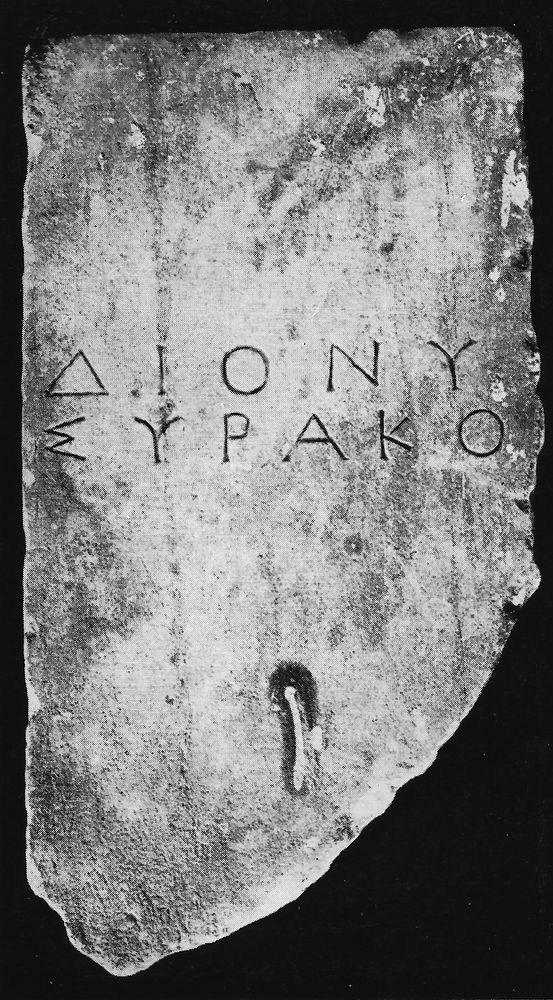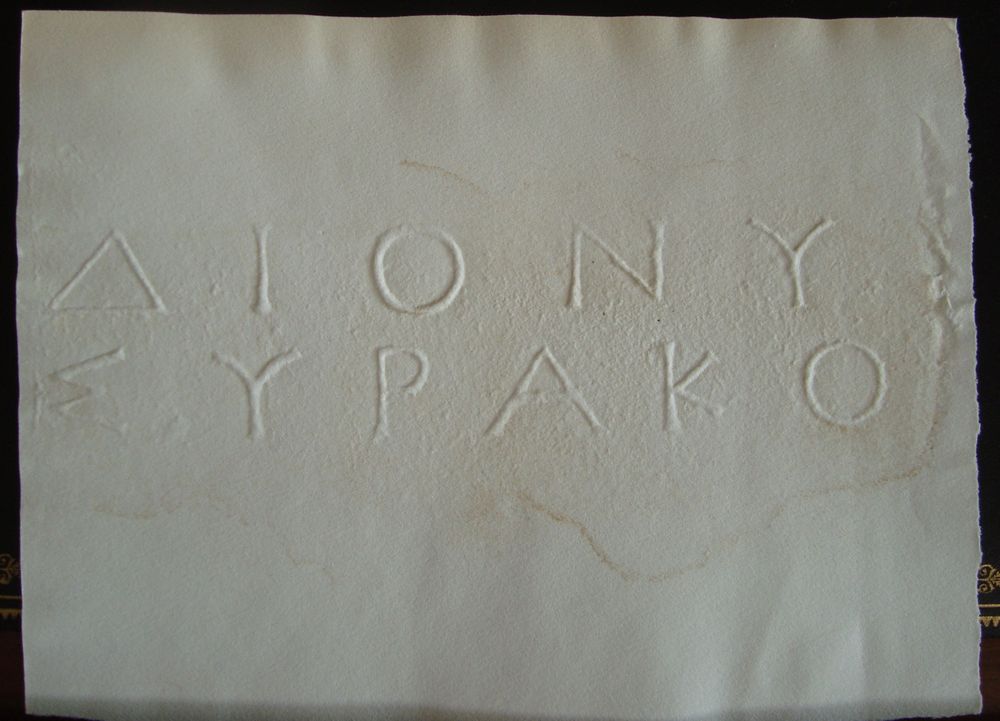EpiDoc XML:
IGCyr1026002
Trismegistos ID:
738535
Source description
Support: Upper left angle of a white marble stele broken at right (perhaps cut for re-use) and below, with anathyrosis on the sides (wide 0.09); present dimensions w: 0.22 × h: 0.395 × d: 0.17; there is a rectangular hole for attachment on top.
Layout: Inscribed in two lines on front face.
Letters: Careful letters, 0.02; very slight serifs, calice shaped-upsilon, symmetrical nu.
Date: Probably beginning of third century BC (lettering).
Findspot: Found in 1929 in the Port of Cyrene, later Apollonia ➚: plausibly from the West Necropolis (see commentary).
Place of origin: Port of Cyrene, later Apollonia ➚.
Last recorded location: Cyrene Museum, 538. Seen by C. Dobias-Lalou in 1977 in Shahat: Cyrene Museum.
Text constituted from: Transcription from stone (CDL).
Bibliography
Oliverio X.49, whence SECir, 205 (ph.); Robert, BE, 1964.582; Reynolds 1976, p. 303, n. 15, whence SEG, 27.1143; IGCyr 102600 ➚.
Text
Apparatus
1: Διονύσ̣[ιος] SECir: Διονύσ̣[ιος ---] Reynolds 1976
2: Συρακο[σίω]: Συρακό[σιος] SECir; Συρακό[σιος] (vac.) Reynolds 1976
French translation
Dionysios fils de Syrakosios (?).
English translation
Dionysios son of Syrakosios (?).
Italian translation
Dionysios figlio di Syrakosios (?).
Commentary
The only evidence about the provenance is that the photograph is dated 'Apollonia 1929'. From that, Reynolds (Reynolds 1976, p. 303, n. 15) deduced that the stone was found in the East Church, thus on re-use. However, the Italian excavations and restorations of that building date from 1920-21 and there was no systematic work of theirs on the site in the following years. Moreover, the sketchbook of Oliverio registering this stone mentions at least one find of 1925. As the monument type is clearly funerary (so Pugliese Carratelli for SECir, 205), it should rather be a chance find from one of the necropoles, namely the Western one, which was at the time being superseded by the new Italian town of Susah.
Both former editors thought that Συρακόσιος was the ethnic. But there seems to be no space available at l. 1 for a father's name, which Reynolds supposed lost at the end of the line. At IGCyr first edition, it seemed thus more plausible that we have here a personal name, the father's name of Dionysios, who then would be no foreigner. Reynolds' restoration of a father's name at line 1 would produce an abnormally broad stele.
For this second edition, two further points should be mentioned. First, the stone is perhaps no stele, for it is not thicker below than on top, as funerary steles usually are. If the hole for attachment on top is taken into account, the stone might rather be a tomb-shutter with a supposed width of c. 44 cm. Furthermore, there is another instance in the Harbour of Cyrene of a funerary stele with only personal name and ethnic without father's name, for a Cretan (IGCyr1330002).
CC BY-NC-SA 4.0 Deed Attribution-NonCommercial-ShareAlike 4.0 International License.
All citation, reuse or distribution of this work must contain a link back to DOI: https://doi.org/10.60760/unibo/igcyrgvcyr2 and the filename (IGCyr000000 or GVCyr000), as well as the year of consultation.


